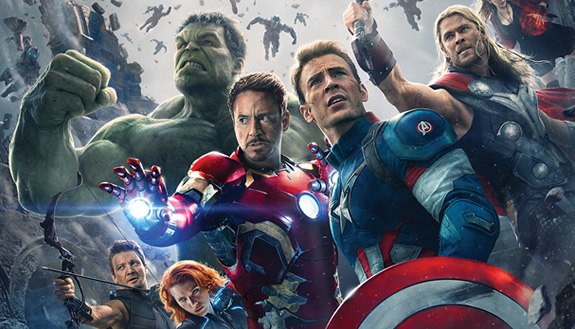When The Avengers came out, it was almost miraculous. Marvel’s serialized cinematic experiment succeeded, and the pure novelty of a superhero team-up movie was more than enough to make the film work like gangbusters. Now, with the novelty worn off, does Avengers: Age of Ultron stand on its own, propel the collective narrative forward in exciting ways, and prove that these films are greater than the sum of their parts?
Somewhat.
The charm and likability of these characters and the people portraying them are still strong, and this sequel does have that breathing room feeling to it; we know these people very well and can now revel in their quirks and personalities. Most of the enjoyable scenes involving the heroes aren’t about how cool they look while taking out bad guys, but are instead just them standing around and being themselves. As is mandated in Marvel movies, this leads to plenty of quips and humorous asides, but it also provides a few moments of introspection and self-examination. For a chaotic action film, it’s telling (and maybe even slightly damaging) that the most affecting parts are the ones that are the most kinetically static.
It’s also telling that the most intriguing and engaging characters are the artificial ones. The titular Ultron is unquestionably Marvel’s best villain. While there is a peppering of Heath Ledger’s Joker in Ultron’s affectations and tone of voice at times, James Spader brings something fresher and more interesting to the table when it comes to Ultron’s characterization: teenage petulance. His know-it-all demeanor makes him disturbingly relatable at times, dredging up memories of when you were in high school and hated the whole stupid world. This childish superiority makes Ultron infinitely watchable, and Spader should be commended for making a genocidal maniac so wickedly lovable.
The other breakout star is Paul Bettany’s Vision. Where Ultron is vicious and knowledgeable, Vision is soft and wise. You can tell that Joss Whedon really dug writing for these two characters, showcasing both sides of the artificial intelligence coin. I can also guarantee that Vision’s first scene and its climax will be the most talked about moment from this film.
But, this is where a symptomatic issue with the film comes into play. Both Ultron and Vision are held back, and not in a good way. This isn’t a situation where these characters are so great that you would love to see more of them. They simply aren’t given enough time. They feel restrained, and that is a criticism I have to lob at the entire film.
It’s not a matter of “the film needs X more minutes,” but rather that the film needed to unchain itself more inside of its running time. And that’s not just in regards to specific characters. Thematically, Avengers: Age of Ultron has an aura of compromise around it. There’s a darkness creeping underneath the film’s surface, and it’s the same shadow that has been creeping underneath many of the other Phase Two efforts. Where Iron Man Three and Captain America: The Winter Soldier plunged headfirst into murkier waters, Avengers: Age of Ultron seems compelled to only dip its toes into the pool.
When it comes to the action sequences, the film’s attitude is much more unhinged. There are plenty of crowd-pleasing moments, but there’s also a frenetic overload in many scenes. This isn’t helped by having most of the enemies be endless swarms of assembly line robots. A lot of individual sequences within the big setpieces blur together, and if not for the more stylish bits of choreography sprinkled throughout, they’d almost be forgettable.
There’s also a self-awareness present in Avengers: Age of Ultron that acts as a double-edged sword at times when it comes to collateral damage. This has always been the stickiest dilemma of superhero stories, and it became an unavoidable aspect thanks to the backlash created by Man of Steel‘s finale. The end battle involves evacuating a city, and in this instance, you feel the heroism such an act is meant to evoke. But, when Iron Man and Hulk are duking it out and Iron Man locates an empty building he can slam the Hulk into, you start to question the humongous damage the destruction of that uninhabited building is doing to the surrounding area. I’m sure that future Marvel films (Captain America: Civil War) are going to tackle this issue, but as it stands, Avengers: Age of Ultron feels like it’s trying a little too hard at times.
I think the most startling quality of Avengers: Age of Ultron is how little of a shakeup it feels like. Sure, things are different by the film’s end, but in comparison to how radical a shift the majority of the Phase Two films underwent, this movie feels more like a concentrated restructuring than an all-out surprise. Avengers: Age of Ultron is the Marvel Cinematic Universe depressurizing and decompressing, which isn’t inherently a bad thing. It just means that this outing feels somewhat slight.
Is Avengers: Age of Ultron bad? No, it’s just lesser than what it should be. With Marvel about to branch out into corners of its universe that are more niche and untapped in the popular consciousness, Avengers: Age of Ultron needed to be an unfettered celebration of characters we may not be seeing for some time. Instead, it’s the most transitory entry since Iron Man 2, taking away from its own needs in order to service what’s coming up ahead. That’s a shame when such provocative characters like Ultron and Vision become casualties of a larger story.
The honeymoon with Marvel has ended with Avengers: Age of Ultron, but the marriage looks like it can make it.
